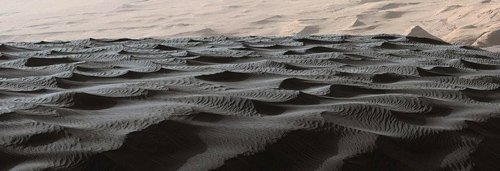
Ripples of sandy terrain on Mars that can be difficult to traverse.
NASA’s Curiosity and MER rovers have each traversed myriad “sandy” regions, which are both pervasive across Mars’ surface and a certainty to be encountered by future missions. On such terrains, rover performance is limited not by wheel torques but by the strength of the material and its ability to support locomotion. Accurate predictions of mobility performance have been, and presently remain, infeasible and the requisite terrain-strength properties are yet to be measured. This precipitates the use of anecdotal evidence and after-the-fact curve-fitting as the state of the art. This study aims to demonstrate that predictive models of rover mobility performance can be greatly informed by terrain strength measurements obtained using the Mars 2020 Abrading Bit, a tool of similar form and function to that of a Bevameter. The results of this study, if transferred into flight, are capable of improving Mars 2020 operations, the design of downstream surface mobility systems, and the generation of accurate Mars regolith analogues.


